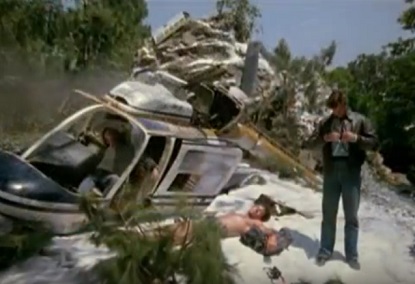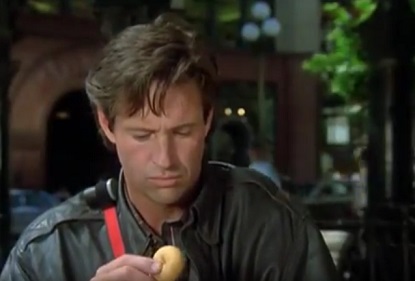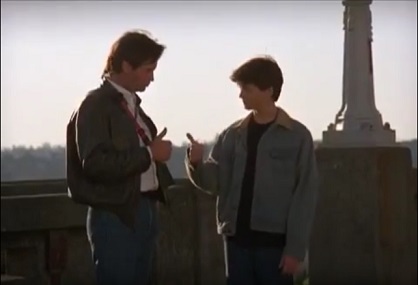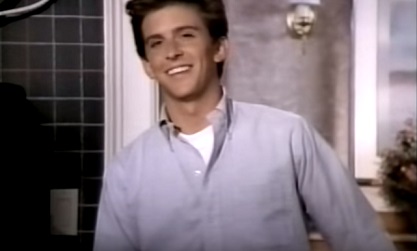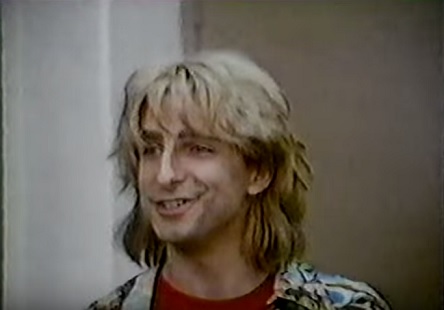Once upon a time, before the internet, it was weird, and even a bit scary for someone to be obsessed over an actor. That was something sad little people did, when they couldn’t find someone real to love. Now, of course, it’s become a normal thing, even over fictitious characters, and spending much of your free time, reading, talking, and writing about your favorite stars is how a lot of people find their tribes, as it were. The 1984 TV movie Obsessive Love, however, is Easy Cheese for the eyes, from back when that kind of behavior was still creepy.
Yvette Mimieux plays Linda Foster, a mousy (by Hollywood standards, meaning she wears glasses and sensible shoes) travel agent leading a lonely existence. Entering middle age, her life seems to be void of joy and meaning, save for Savage Hills, her favorite soap opera, and its star, the devastatingly handsome Glen Stevens (Simon MacCorkindale). Her drab little apartment is a veritable shrine to Glen, and the highlight of her day is watching his show during her lunch hour.

Who let this monster out of her cage?
After a disastrous blind date, Linda decides to start living her best life, emptying her savings account, buying a plane ticket to California, and treating herself to a posh hotel suite. She tells her mother that she’s going there to spend a few days with her boyfriend, a man who, by Linda’s description, sounds an awful lot like Michael, the character Glen plays. Once she gets an extravagant makeover (and you know what that means–so long, glasses!), Linda sets about tracking down her man.
Suddenly and bafflingly cured of her shyness, she cons her way on to the set of Savage Hills, then later tricks Glen into believing that she’s a journalist. He agrees to let her spend the whole day alone with him for a supposed “interview” on his boat–hilariously, it’s suggested that Linda spends the night beforehand studying up on boats and sailing, as if they’re going to take an exam to join the Coast Guard instead of just sitting around drinking white wine and talking about Glen’s acting career.
It’s already established that Glen is unhappy with his role on Savage Hills, and the stress of it is causing a strain on his marriage. Linda, who found out about the latter literally by standing outside of Glen’s house and eavesdropping on an argument between him and his wife, focuses right in on this, playing him like a handsome, ascot wearing fiddle. Even after admitting that she’s lying about being a journalist, Linda claiming that she understands how hard it is being a beloved millionaire TV star is enough to put Glen under her spell, and it’s not long before they’re passionately tussling on the beach.
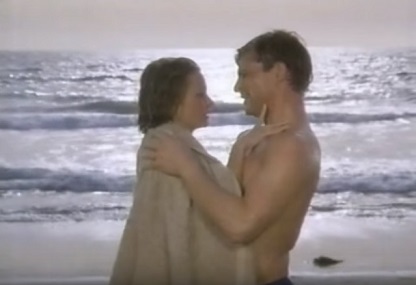
“I loved you in Jaws 3D.”
Red flags go up almost immediately, however, when, the very next morning, Glen overhears Linda telling her mother on the phone that they’re going to get married (not to mention that she also calls him “Michael”). Unsurprisingly, Glen is not amenable to this, and tells Linda that, while he surely did appreciate all the boning, it didn’t really mean anything to him. Unsurprisingly, Linda is not amenable to that, and she sets about stealing Glen (or Michael, rather, it’s the fictitious Michael she really wants) all for herself.
Convincing everyone Glen knows with startling ease that they’re madly in love and planning to marry, she forces his wife to leave him, and even encourages Savage Hills‘s head writer (Lainie Kazan) to write their love story into the plot! The only person who sympathizes with him initially is a private detective friend who does a little digging around and finds out that Linda was once locked up in a psychiatric hospital and is believed to be an “undiagnosed schizophrenic” (back when “schizophrenic” was a lazy, catch-all term for “really fucking crazy”).
Eventually, Glen decides that the only way he can free himself from Linda’s clutches is by destroying the man she really loves. He talks the head writer into writing Michael out of Savage Hills forever–by having him killed off on screen! Linda is devastated, but when next we see her, in another psychiatric hospital, she seems to be doing a lot better. She’s even fallen in love with someone new–another character on a different soap opera.

Linda and Glen enjoy their casual, relaxed relationship.
Despite Glen’s clever solution, the results are disappointingly anticlimactic. Linda just cries, and then it cuts to her sweetly talking to a television. Undoubtedly giving in to public demand, Obsessive Love was released on home video in 1988, and the commercial for it pushes hard its similarity to Fatal Attraction (it also laughably mentions its “terrific low price” of just $59.98). Despite its promising premise, however, Obsessive Love never really gets down to the level of entertainingly sleazy trash that it’s supposed to be. Everything is very subdued–even Glen and Linda’s love scene just consists of them kissing on the beach before the camera discreetly pans away. Though references are made to Linda’s supposed volatile temper, she barely even raises her voice at any point. Where’s the knock down, drag out fight at the end? How did Glen’s private eye buddy not end up a corpse hidden in the trunk of Glen’s car? Where’s the goddamn saxophone music?
It does take one interesting step, in initially making Linda seem sympathetic. It’s no wonder she absorbs herself in a fantasy world, considering that everyone in her real, pre-makeover life is kind of awful, from her overbearing mother to a pushy co-worker who sets her up on a blind date with a slimeball. Even strangers either ignore her or treat her with a withering pity that borders on contempt. Giant, unflattering glasses or no, Yvette Mimieux is simply far too attractive for people to be treating her character like a bug on their windshield. If anything, once she starts looking like a generic 80s soap opera villainess (big hair, bigger shoulder pads), her character, and the movie, suddenly gets a lot more boring.


